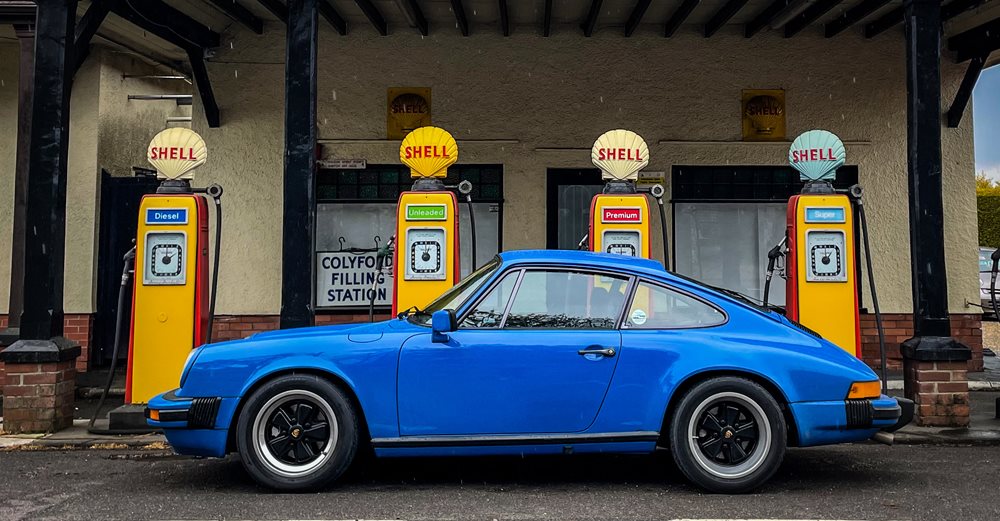911SC and E10 Fuel

Summary
E10 fuel has recently arrived at our pumps. The E stands for Ethanol and 10 means it is 10% by volume of the fuel. The old fuel only had 5%, hence E5.
There have been many articles published over the last 6 months about its use for classic cars. And we are often asked :
“is my SC is ok to run from E10’ or must it be E5, will it do any damage to the fuel system or engine?”
This article only goes into the basic do’s and don’ts rather than the technical detail. There are several links listed below which describe the details if that what’s you are after and we encourage you to take the time to watch the two very informative videos we have also put the links for at the end of this article.
So let’s start off with a few facts:
- More ethanol in the fuel – increased from 5% to 10%
- Ethanol Absorbs water (hydroscopic) – The CIS manual does warn that this system is sensitive to water contamination.
- Ethanol has slightly lower octane – lower energy content. This translates between 1% to 3% lower mpg
To cut to the chase you can use E10 if that is your only option but you must not store the car with a tank of E10. So if you fill up with E10, drive and use most of the tank, then fill up with E5 and store the car for 6 months you will be fine. It’s always good to fill the tank right up to stop water condensing and causing it to rust. So fill up with E5 when you store the car.
Being hydroscopic, should it absorb enough water, say from fuel tank condensation when you store your Porsche, then Phase Separation is possible, where water separates from the fuel.
So you do not want E10 sitting in your fuel system for any amount of time.
E10 will pull water out of the air (fuel tank is vented to the air), rubber and seals.
This may have the effect of drying the seals out over time. How long this will take is another question.
The best solution is to avoid this and use the E10 up in your tank and store your Porsche with E5.
There have been some complaints in the press about poor mpg and some cars not running so well on E10. With the slightly lower octane rating this could have some effect. I ran my 20 year old V5 golf off E10 while there were some fuel shortages and had no problem at all. I did top up with E5 when I could.
Parts Breakdown
The key components of the SC fuel system are:
Fuel Tank: Vented to the atmosphere so E10 can absorb moisture from the air. Minimise head space in the tank – less air. Fuel left in the tank for a stored vehicle can begin to break down in as little as 30-60 days. This can cause gum, varnish, rust and corrosion to build up in the fuel lines and engine. Keep the tanks full when stored and use your SC when you can.
Fuel pipes – may be able to upgrade them to E10 friendly versions in the future when they need changing.
Fuel pump - Aluminium case with steel internals.
Warm start regulator – Aluminium case with steel inserts. This is a pressure device with small holes you do not want to get clogged up. Pressure is controlled by a diaphragm which is temperature controlled by a heated element.
Fuel distributor – Made of Aluminium with lots of rubber seals. This controls the volume and pressure of fuel sent to the injectors.
Accumulator – Made of steel with two chambers separated by a diaphram. The accumulator dampens fuel pressure pulses from the fuel pump and maintains fuel pressure to help with warm staring. The diaphragm is sensitive to contamination.
Fuel injectors – Made from steel with steel pipes. If you seals deteriorated then this would cause the engine to run poorly.
Fuel filter – should not be a problem when regular change when serviced.
Cold start Valve – Made from steel. Will cause poor starting if it clogs up.
Links
Key links for the E10 discussion are:
https://www.porscheclubgb.com/news-and-events/news/2021/september/fuelling-your-classic-porsche-with-e10-petrol
https://www.porsche.com/uk/aboutporsche/pressreleases/pcgb/?lang=none&pool=uk&id=2011-05-23-classic&fbclid=IwAR0Rij8lmclJGEy2AauzMho-oob8dO5z7vOmzQJKe0n3sZgUNrF5URyiysI
Video 1:
https://www.youtube.com/watch?v=RPbdKszvMxM
Video 2:
https://www.youtube.com/watch?v=ATGSBi1kBl0
Richard Stephens, 911SC Tech Advisor, January 2021